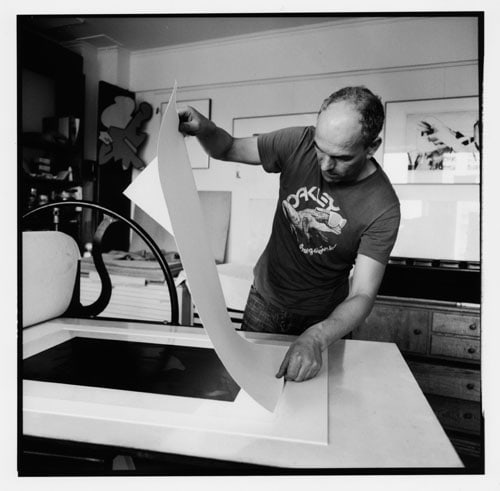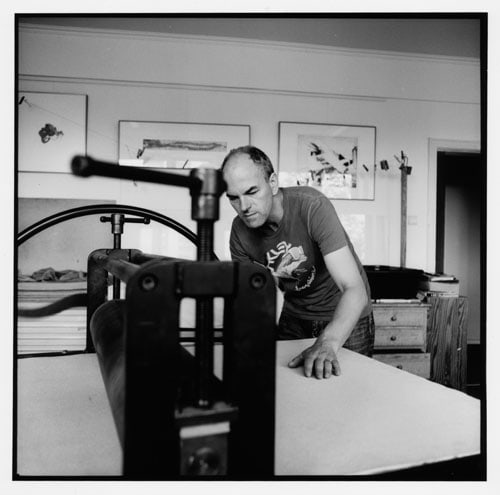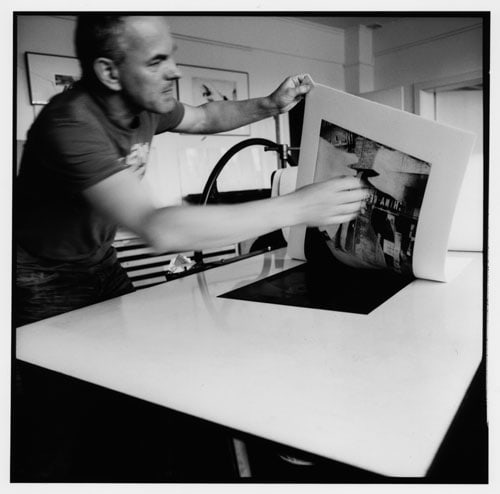


Intaglio Printing
The Vintage Look
This noble printing process is a symbiosis of classical etching and photography. Each print on the etching board is unique. The application of the oil ink, the rubbing out of the etching plate with gauze and the printing on the etching press are all done by hand for each print, just as with copperplate engravings.
I started my first experiments in photo-polymer gravure after I read an article in a trade magazine about the New York based photographer Peter Liepke, which aroused my curiosity. From his New York photographs, he first makes platinum/palladium prints or rubber prints, and then has a "Special Photogravure Edition" printed on the etching press.
As a photographer, I had already been working exclusively digitally for many years. However, I did not want to go back to the analogue darkroom with all the photochemistry. The classic heliogravure, in which a photographic template is etched into the copper plate using acid, was also out of the question for me. So I looked for a way to combine my photography with photogravure. In the process I came across the still very young technique of photo-polymer intaglio printing. It took 1 year and many many attempts until I was able to print the first intaglio print as I wanted it. I learned intaglio printing with copper plate, oil paint and etching press from the artist Sven Wohlgemuth in Hamburg.
The intagliotype etching technique is a "non-toxic intaglio printmaking": Instead of etching directly into the copper plate with toxic acid as in heliogravure, a thin photo-polymer layer is squeegeed onto the plate by hand in a darkened room with the help of a water sprayer. This layer is light-sensitive and still uncured. The remaining moisture between the copper plate and the polymer layer is pressed out in the etching press and the plate is then dried overnight in the dark. The next day, the printing plate is ready for exposure to the motif. The motif, which was previously printed on a transparent film with an inkjet printer and black pigment ink in the finest possible resolution, is then burned into the printing plate in direct contact under vacuum with UV light. Since the polymer only hardens when irradiated with UV light, the black pigment ink of the inkjet printer has the advantage that it does not let any light through. As a result, the polymer remains soft under every black pigment ink dot, no matter how fine, during exposure. Consequently, every tiny splash of black on the film from the inkjet printer causes a depression in the printing plate, and all the transparent areas on the film that let the UV light through harden the polymer layer. The image consists of many tiny depressions into which the oil ink is rubbed. To expose the plate, I use a 300kg contact copier from the analogue times of the Theimer company from the 1980s. This machine has a 1000 watt UV lamp and a heavy vacuum frame.
Before the gravure plate can be rubbed with oil ink, the soft unexposed polymer has to be removed from the plate. To do this, the exposed plate is briefly placed in a bowl of washing lye or washing soda. The alkaline soda dissolves the soft polymer out of the depressions. After a short intermediate rinse in water, the polymer layer with the depressions is fixed and hardened in an acidic vinegar bath.
The printing on paper that follows is identical to traditional copperplate engraving and classical etching. The printing plate is rubbed with oil paint and wiped out by hand with gauze in many passes until the oil paint is only left in the depressions. When the plate is ready for printing, it is placed on the printing table of the etching press. A damp etching board is carefully placed over it, the whole thing is covered with a printing felt and together the printing plate and copper printing paper are moved through the rollers of the etching press by slowly spinning a large flywheel. The pressure of the steel rollers, which weighs tons, the moisture in the etching board and the felt mat transfer the oil ink from the depressions in the printing plate onto the etching board. The print is complete. For each subsequent print, the printing plate is again rubbed with oil ink and wiped with gauze.
Since the depressions are not etched into the copper plate with acid, as is the case with heliogravure, but are exposed into the overlying photo-polymer layer, the copper plate can be reused for other motifs after the edition has been printed. When soaking for a longer time in a bath of washing lye, the photo-polymer dissolves from the copper plate.
For the intaglio prints I use a etching board from Hahnemühle. The real handmade paper for artistic printing techniques is produced in individual sheets on a cylinder mould paper machine. It is acid-free and resistant to ageing. All intaglio prints are original prints made by myself.